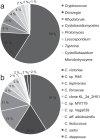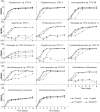The isolation and characterization of resident yeasts from the phylloplane of Arabidopsis thaliana
- PMID: 28004784
- PMCID: PMC5177952
- DOI: 10.1038/srep39403
The isolation and characterization of resident yeasts from the phylloplane of Arabidopsis thaliana
Abstract
The genetic model plant Arabidopsis thaliana (arabidopsis) has been instrumental to recent advances in our understanding of the molecular function of the plant immune system. However, this work has not yet included plant associated and phytopathogenic yeasts largely due to a lack of yeast species known to interact with arabidopsis. The plant phylloplane is a significant habitat for neutral-residents, plant-growth and health-promoting species, and latent-pathogenic species. However, yeast phylloplane residents of arabidopsis remain underexplored. To address this, resident yeasts from the phyllosphere of wild arabidopsis collected in field conditions have been isolated and characterized. A total of 95 yeast strains representing 23 species in 9 genera were discovered, including potentially psychrophilic and pathogenic strains. Physiological characterization revealed thermotolerance profiles, sensitivity to the arabidopsis phytoalexin camalexin, the production of indolic compounds, and the ability to activate auxin responses in planta. These results indicate a rich diversity of yeasts present in the arabidopsis phylloplane and have created culture resources and information useful in the development of model systems for arabidopsis-yeast interactions.
Figures






Similar articles
-
Yeasts from phylloplane and their capability to produce indole-3-acetic acid.World J Microbiol Biotechnol. 2012 Dec;28(12):3323-35. doi: 10.1007/s11274-012-1144-9. Epub 2012 Aug 11. World J Microbiol Biotechnol. 2012. PMID: 22886557
-
Isolation and characterization of psychrophilic and psychrotolerant plant-growth promoting microorganisms from a high-altitude volcano crater in Mexico.Microbiol Res. 2020 Feb;232:126394. doi: 10.1016/j.micres.2019.126394. Epub 2019 Dec 14. Microbiol Res. 2020. PMID: 31865222
-
Diversity of culturable yeasts in phylloplane of sugarcane in Thailand and their capability to produce indole-3-acetic acid.World J Microbiol Biotechnol. 2014 Jun;30(6):1785-96. doi: 10.1007/s11274-014-1602-7. Epub 2014 Jan 19. World J Microbiol Biotechnol. 2014. PMID: 24442819
-
Sulfur-containing secondary metabolites from Arabidopsis thaliana and other Brassicaceae with function in plant immunity.Chembiochem. 2012 Sep 3;13(13):1846-59. doi: 10.1002/cbic.201200086. Epub 2012 Jul 16. Chembiochem. 2012. PMID: 22807086 Review.
-
[The "chemical defense" of plants against pathogenic microbes: Phytoalexins biosynthesis and molecular regulations].Ying Yong Sheng Tai Xue Bao. 2020 Jul;31(7):2161-2167. doi: 10.13287/j.1001-9332.202007.018. Ying Yong Sheng Tai Xue Bao. 2020. PMID: 32715677 Review. Chinese.
Cited by
-
The microbiome of alpine snow algae shows a specific inter-kingdom connectivity and algae-bacteria interactions with supportive capacities.ISME J. 2020 Sep;14(9):2197-2210. doi: 10.1038/s41396-020-0677-4. Epub 2020 May 18. ISME J. 2020. PMID: 32424246 Free PMC article.
-
Shaping the leaf microbiota: plant-microbe-microbe interactions.J Exp Bot. 2021 Jan 20;72(1):36-56. doi: 10.1093/jxb/eraa417. J Exp Bot. 2021. PMID: 32910810 Free PMC article.
-
The Leaf Microbiome of Arabidopsis Displays Reproducible Dynamics and Patterns throughout the Growing Season.mBio. 2022 Jun 28;13(3):e0282521. doi: 10.1128/mbio.02825-21. Epub 2022 Apr 14. mBio. 2022. PMID: 35420486 Free PMC article.
-
Large scale production of indole-3-acetic acid and evaluation of the inhibitory effect of indole-3-acetic acid on weed growth.Sci Rep. 2021 Jun 22;11(1):13094. doi: 10.1038/s41598-021-92305-w. Sci Rep. 2021. PMID: 34158557 Free PMC article.
-
The dark septate endophyte Phialocephala sphaeroides suppresses conifer pathogen transcripts and promotes root growth of Norway spruce.Tree Physiol. 2022 Dec 12;42(12):2627-2639. doi: 10.1093/treephys/tpac089. Tree Physiol. 2022. PMID: 35878416 Free PMC article.
References
-
- van der Lelie D. et al.. Poplar and its Bacterial Endophytes: Coexistence and Harmony. Critical Reviews in Plant Sciences 28, 346–358, doi: 10.1080/07352680903241204 (2009). - DOI
-
- Rodriguez R. J. et al.. Stress tolerance in plants via habitat-adapted symbiosis. ISME J 2, 404–416 (2008). - PubMed
-
- Marschner H., Römheld V., Horst W. J. & Martin P. Root-induced changes in the rhizosphere: Importance for the mineral nutrition of plants. Zeitschrift für Pflanzenernährung und Bodenkunde 149, 441–456, doi: 10.1002/jpln.19861490408 (1986). - DOI
-
- Nakasel’s T. et al.. Ballistoconidium—Forming Yeasts Found in the Phyllosphere of Thailand. Group 500 (1987).
Publication types
MeSH terms
Substances
LinkOut - more resources
Full Text Sources
Other Literature Sources

